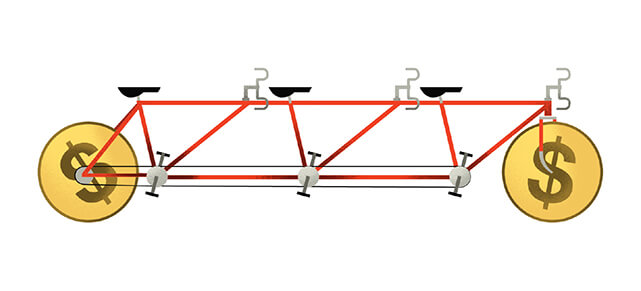From its official beginnings in the mid-1800s, the modern-day cooperative movement has been driven by groups of individuals fed up with economic and social inequality, believing they had a better way of doing business.
The co-op model, where businesses are owned and run by and for their members, was born out of both disappointment and idealism, beginning with Britain’s Rochdale Society of Equitable Pioneers, a group of labourers who banded together in 1844 to open their own, more affordable food store and share the profits.
The co-op movement soon gained momentum, particularly after the Great Depression, as more people came together to better cope with poverty and a scarcity of food and other basic goods.
Co-ops have since grown exponentially, around the world and across various sectors, from food and agriculture to health care and financial services, amid a number of global market ups and downs.
Even today, co-ops are based on seven principles penned by the Rochdale Pioneers, considered the prototype of the modern cooperative society. They are also built on similar values such as democracy, equality and solidarity – which tend to resonate most during tumultuous times.
“The real growth [of co-ops] occurs when there’s a time of crisis,” says Charles Gould, director-general of the Belgium-based International Co-operative Alliance (ICA). “People are looking for a way to deal with it.”
Once formed, many cooperatives remain intact, longer than many other business models such as corporations and partnerships, argues Gould. “The cooperative model by design is more participative,” he says. “It’s more sustainable.”
For example, a 2008 study from Quebec’s economic development ministry shows the survival rate of co-ops in that province was 62 per cent after five years and 44 per cent after 10 years, compared to 35 per cent over five years and 19.5 per cent over 10 year for other new businesses.
Today’s co-op sector is estimated to have about one billion members worldwide, employing more than 100 million people, 20 per cent more than multinational corporations, according to data compiled by the ICA.
The world’s 300 largest cooperatives — 10 of which are Canadian — have aggregate sales of $2.1 trillion, according to the ICA. The U.S. dominates with more than 30,000 co-ops or 256 million members, followed by India, Japan and Iran. Canada has about 9,000 co-ops representing 18 million members. The ICA also says four out of every 10 Canadians belong to at least one co-op, which includes about 70 per cent of Quebec’s population and 56 per cent of people in Saskatchewan.
The co-op business model also appears to be gaining clout, especially in the wake of the most recent global financial crisis. In some countries, the failure of investor-owned banks has driven more consumers to financial cooperatives, which fared better during the downturn, according to the Geneva-based International Labour Organization (ILO).
In a study released last year, the ILO said most co-ops came through the financial crisis without a government bailout, while continuing to lend to people and businesses. It found that co-op bank assets in Europe grew 10 per cent between 2007 and 2010, while the number of co-op bank customers increased 14 per cent. What’s more, it says co-op bank profits increased 7.5 per cent between 2003 and 2010 compared to 5.7 per cent for investor-owned banks.
“Unlike many investor-owned banks, they maintained very good credit ratings, increased their assets and customer base and the minority that suffered losses quickly bounced back and are growing again,” states the report’s author, Johnston Birchall.
The United Nations has also highlighted the resilience of cooperatives throughout economic crises, and the benefits for members, employees and customers. “They have maintained high credit ratings, increased assets and turnover, and expanded their membership and customer base,” UN resident coordinator Simon Springett said in a speech last year.
The ICA’s Gould sees a steadily growing acceptance of the co-op model, especially among today’s youth, whom he says are more inclined towards collaboration, thanks in part to social media and investment models such as crowdfunding.
“The sense that everyone can gain if you share, rather than keep information hidden for competitive advantage, that’s more commonly believed today than when I started in business 30 years ago,” Gould says. “We believe we’re at a point in history when people are frustrated with the economic and social models that have dominated their lives. They’re looking for a greater voice.”
Building profile
The challenge for co-ops has and continues to be convincing the broader market that its business model is long-lasting, more risk averse and not just for smaller-scale organizations.
“The cooperative is a serious business model,” Gould says.
He points to a couple of American examples including Ocean Spray, an agriculture cooperative of cranberry and grapefruit growers with more than 700 members across North America; and Land O’Lakes, a farmer-owned food and agricultural co-operative that ranked 199 on the Fortune 500 with more than $14.2 billion (U.S.) in annual sales in 2013.
Gould believes economies are better off with a mix of co-ops alongside other private and public companies.
“We’ve never wanted world domination,” he says. “We’ve never felt that everything ought to be done through a co-op. We just think it’s a very effective model for people to deal with lifting their livelihood, having control of their business … and helping make decisions that benefit community.”
The credibility and sustainability messages are ones that today’s cooperative movement is working hard to spread, especially since 2012 was declared the United Nations International Year of Cooperatives. The ICA has developed a “2020 vision,” which calls for co-ops to become the fastest-growing form of enterprise by the end of the decade, and known for their leadership in economic, social and environmental sustainability.
“To me, they seem like the perfect fit for a lot of challenges we’re facing; whether it’s inequality or climate change or a host of other issues,” says Yuill Herbert, director at the Sustainability Solutions Group, a collective of Canada’s leading sustainability professionals. “They’re grounded in community, they’re democratic, they’re long term… They are extremely compatible with the sustainability agenda.”
Co-ops aren’t perfect, and they’re not suited to every industry, but Herbert argues many are at the forefront of their industries today when it comes to economic sustainability.
A better model
Canada has its share of successful and sustainable co-ops, dating back to before the start of the 20th century. One of the oldest co-ops is Desjardins, founded in 1900 and the first savings and credit cooperative established in North America. Desjardins has since grown into the largest financial cooperative in Canada, with a network of caisses populaires (credit unions) and about 20 subsidiary companies in insurance, securities, venture capital and asset management.
Another is Federated Co-operatives Ltd., an animal feed, crop supply and petroleum co-op established in 1955 to form provincial wholesale cooperatives as a way to increase their buying power. Today, it is owned by about 225 retail co-ops located throughout Western Canada, which reported record sales of $9.4 billion in 2013.
The Home Hardware co-op, celebrating its 50th anniversary this year, had similar beginnings. It was created by a group of 122 hardware dealers trying to cope with increased competition from big-box retailers that were blamed for the closure of more than 1,000 independent hardware stores between 1955 and 1965. By joining forces, the Home Hardware dealers believed they could survive by combining buying power, marketing and advertising power, and other resources.
Home Hardware has since grown to 1,067 dealer-owned locations across Canada, with revenues totalling more than $5.4 billion in 2013, up from $4.2 billion a decade earlier. Its market share increased to 13.3 per cent in 2013, up from 10.6 per cent in 2006.
“As a large player today we are carrying forth the very same advantage we were looking for when (50 years ago) 122 dealers banded together,” says Home Hardware chief executive officer Terry Davis.
Davis says that’s different from a publicly listed company, which must also answer to other interests from stockholders and investment bankers. “The fact that we have no other interests we have to care about … and because we’re not trying to make a profit … I think that’s why the model has done so well.”







